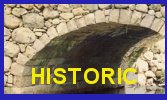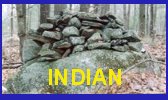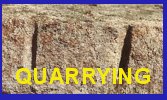



Robert Mullicken, Sr. (1668-1741)
In 1708 John Hartshorn left Haverhill and moved a couple of towns south to Rowley. Hartshorn continued to carve gravestones for Haverhill and Bradford until Robert Mullicken, Sr. decided to take up the trade.
Robert Mullicken, Sr. was a weaver from Bradford. Like his predecessor he took up carving as a second career and later in life. Robert was about forty five years old. Within a couple of years Robert begins to carve designs similar to Hartshorn and his work improves dramatically. From that point on Hartshorn who no doubt taught Robert his method and style, stopped carving for Haverhill and Bradford. Robert had married a woman from Newbury which brought him business from that town, too. Although Robert used the same mask-like face and large circles with geometric designs as Hartshorn he distinguished his work by using non-connected designs inside the lunette (top section).
 |
Stars and stylized fleur-de-lis Dorkes Bartlet – 1719 – Newburyport, MA
Stars were a creation of Robert’s. He also used several variations of fleur-de-lis as common designs. On this stone there is a mix of fine line carving and raised geometric designs. The combination is common on Robert Mullicken, Sr.’s gravestones.
 |
Skull and Wings Captain Phillip Atwood – 1722 – Bradford, MA
This skull and wings was one of only two R. Mullicken, Sr. used. Both were on captains gravestones. He ceased to carve this design afterwards. It is possible his patrons did not want the skull and wings design. Boston gravestones never made it into Bradford or Haverhill. So in carving this design Mullicken clearly made these two men stand out.
 |
Whorls and Flowers John Sawyer – 1723 – Newburyport, MA (formerly Newbury)
Robert Mullicken, Sr. had several circle designs he used regularly. Whorls and six pedaled flowers were two. On this stone he carved hearts as secondary designs. He changed his secondary designs about every two years. In doing so, he was able to continuously create different gravestones every time.
 |
Wavy lines above head Captain Hugh March – 1727 – West Newbury, MA
Placed above the head is a pair of wavy lines. They appear to have been used as a design feature without symbolism. To make this captain stand out he used a tall fancy secondary design under the face and a large, tall gravestone. The large size allowed Mullicken to carve oversized circles. The fancy pie design beside the face and simple pie design in the finial are other examples of his circle designs.

